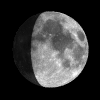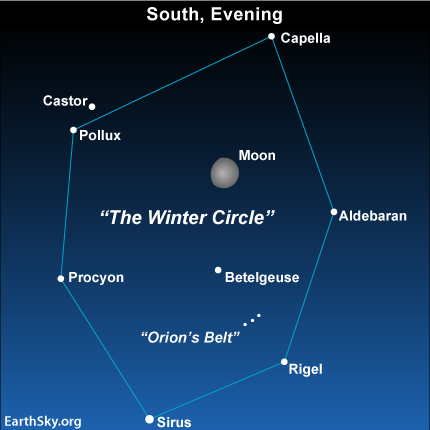Courtesy of EarthSky
A Clear Voice for Science
Visit EarthSky at
www.EarthSky.org

 Tonight’s waxing gibbous moon resides inside the Winter Circle – an incredibly large star configuration made of six brilliant winter stars. Be sure to notice the variety in the colors of these stars.
Tonight’s waxing gibbous moon resides inside the Winter Circle – an incredibly large star configuration made of six brilliant winter stars. Be sure to notice the variety in the colors of these stars.
The Winter Circle – sometimes called the Winter Hexagon – is not one of the 88 recognized constellations. Rather, it is an asterism – a pattern of stars that is easy to recognize. Our sky chart cannot adequately convey the Winter Circle’s humongous size! It dwarfs the constellation Orion the Hunter, which is a rather large constellation, occupying the southwestern part of the Winter Circle pattern.
More on the Winter Circle: Brightest winter stars
Here is how to locate the Winter Circle from mid-northern latitudes. At nightfall and early evening, look high overhead for the bright star Capella. This star marks the top (or more properly, the northern terminus) of the Winter Circle.
As Capella shines way overhead, the constellation Orion the Hunter is prowling in the southern sky. Draw a line downward through Orion’s Belt to find Sirius, the brightest star in the night sky. This star marks the bottom (the southern tip) of the Winter Circle.
We include this sky chart to help you connect the Winter Circle stars.
By the way, tonight’s waxing gibbous moon also nearly aligns with the June solstice point – where the sun resides in front of the backdrop stars on the first day of a northern hemisphere summer. So, enjoy the Winter Circle and contemplate the return of summer – months from now!
Written by Deborah Byrd![]()
Astronomy Picture of the Day from NASA/JPL
U.S. Naval Observator Astronomical Information center
The York County Astronomical Society